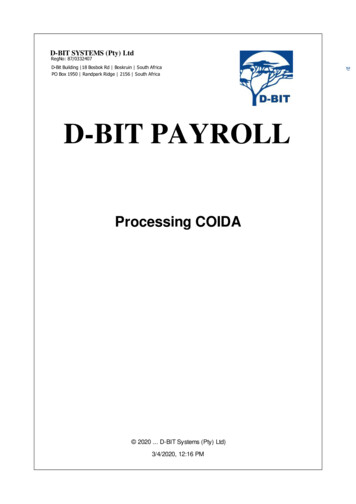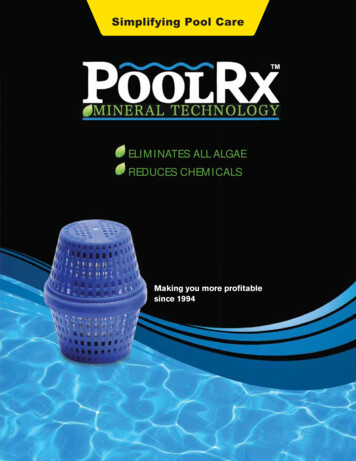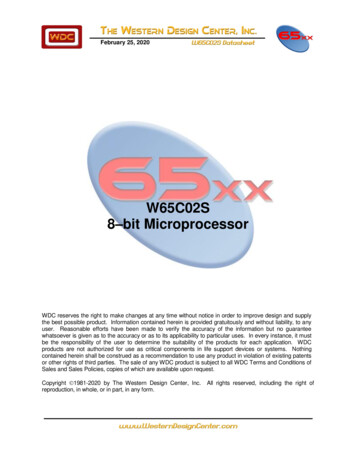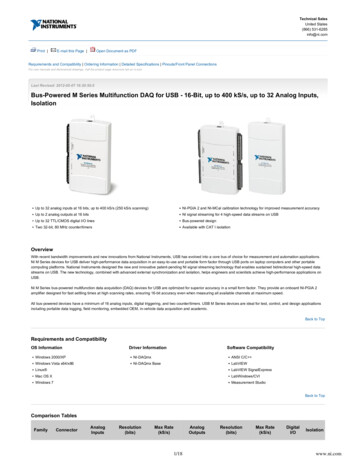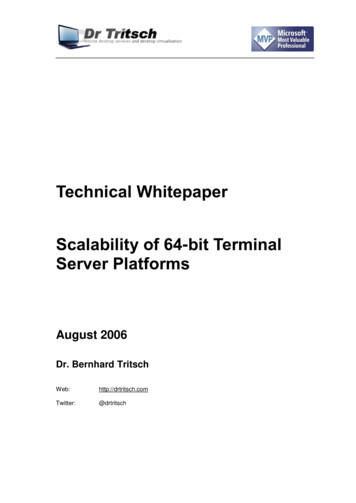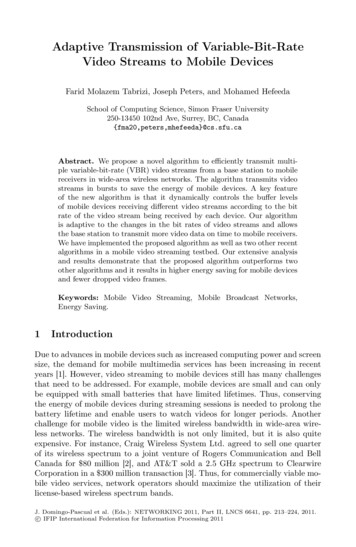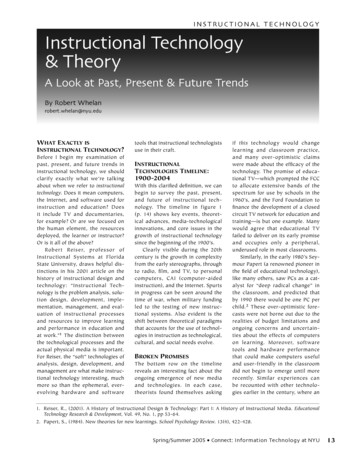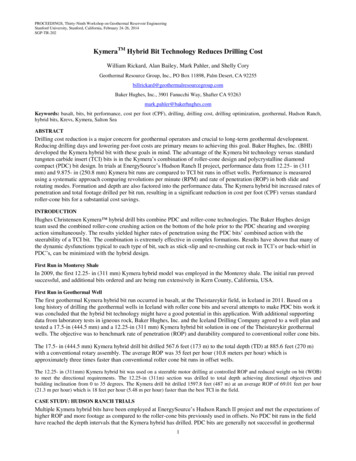
Transcription
PROCEEDINGS, Thirty-Ninth Workshop on Geothermal Reservoir EngineeringStanford University, Stanford, California, February 24-26, 2014SGP-TR-202KymeraTM Hybrid Bit Technology Reduces Drilling CostWilliam Rickard, Alan Bailey, Mark Pahler, and Shelly CoryGeothermal Resource Group, Inc., PO Box 11898, Palm Desert, CA 92255billrickard@geothermalresourcegroup.comBaker Hughes, Inc., 3901 Fanucchi Way, Shafter CA 93263mark.pahler@bakerhughes.comKeywords: basalt, bits, bit performance, cost per foot (CPF), drilling, drilling cost, drilling optimization, geothermal, Hudson Ranch,hybrid bits, Krevs, Kymera, Salton SeaABSTRACTDrilling cost reduction is a major concern for geothermal operators and crucial to long-term geothermal development.Reducing drilling days and lowering per-foot costs are primary means to achieving this goal. Baker Hughes, Inc. (BHI)developed the Kymera hybrid bit with these goals in mind. The advantage of the Kymera bit technology versus standardtungsten carbide insert (TCI) bits is in the Kymera’s combination of roller-cone design and polycrystalline diamondcompact (PDC) bit design. In trials at EnergySource’s Hudson Ranch II project, performance data from 12.25- in (311mm) and 9.875- in (250.8 mm) Kymera bit runs are compared to TCI bit runs in offset wells. Performance is measuredusing a systematic approach comparing revolutions per minute (RPM) and rate of penetration (ROP) in both slide androtating modes. Formation and depth are also factored into the performance data. The Kymera hybrid bit increased rates ofpenetration and total footage drilled per bit run, resulting in a significant reduction in cost per foot (CPF) versus standardroller-cone bits for a substantial cost savings.INTRODUCTIONHughes Christensen Kymera hybrid drill bits combine PDC and roller-cone technologies. The Baker Hughes designteam used the combined roller-cone crushing action on the bottom of the hole prior to the PDC shearing and sweepingaction simultaneously. The results yielded higher rates of penetration using the PDC bits’ combined action with thesteerability of a TCI bit. The combination is extremely effective in complex formations. Results have shown that many ofthe dynamic dysfunctions typical to each type of bit, such as stick-slip and re-crushing cut rock in TCI’s or back-whirl inPDC’s, can be minimized with the hybrid design.First Run in Monterey ShaleIn 2009, the first 12.25- in (311 mm) Kymera hybrid model was employed in the Monterey shale. The initial run provedsuccessful, and additional bits ordered and are being run extensively in Kern County, California, USA.First Run in Geothermal WellThe first geothermal Kymera hybrid bit run occurred in basalt, at the Theistareykir field, in Iceland in 2011. Based on along history of drilling the geothermal wells in Iceland with roller cone bits and several attempts to make PDC bits work itwas concluded that the hybrid bit technology might have a good potential in this application. With additional supportingdata from laboratory tests in igneous rock, Baker Hughes, Inc. and the Iceland Drilling Company agreed to a well plan andtested a 17.5-in (444.5 mm) and a 12.25-in (311 mm) Kymera hybrid bit solution in one of the Theistareykir geothermalwells. The objective was to benchmark rate of penetration (ROP) and durability compared to conventional roller cone bits.The 17.5- in (444.5 mm) Kymera hybrid drill bit drilled 567.6 feet (173 m) to the total depth (TD) at 885.6 feet (270 m)with a conventional rotary assembly. The average ROP was 35 feet per hour (10.8 meters per hour) which isapproximately three times faster than conventional roller cone bit runs in offset wells.The 12.25- in (311mm) Kymera hybrid bit was used on a steerable motor drilling at controlled ROP and reduced weight on bit (WOB)to meet the directional requirements. The 12.25-in (311m) section was drilled to total depth achieving directional objectives andbuilding inclination from 0 to 35 degrees. The Kymera drill bit drilled 1597.8 feet (487 m) at an average ROP of 69.01 feet per hour(21.3 m per hour) which is 18 feet per hour (5.48 m per hour) faster than the best TCI in the field.CASE STUDY: HUDSON RANCH TRIALSMultiple Kymera hybrid bits have been employed at EnergySource’s Hudson Ranch II project and met the expectations ofhigher ROP and more footage as compared to the roller-cone bits previously used in offsets. No PDC bit runs in the fieldhave reached the depth intervals that the Kymera hybrid has drilled. PDC bits are generally not successful in geothermal1
Rickard et al.applications. The formations are very inconsistent, abrasive and much more highly fractured than drillers encounter intypical oil and gas environments, where PDC bits are generally successful. All previous attempts to use PDC bits in theformations were met with very limited success while roller-cone bits significantly outperformed the PDC bits on a dollar( USD) per foot basis, as a past norm.In 2012, Geothermal Resource Group (GRG) tested the Kymera hybrid bits in production drilling. The results have proventhe hybrid’s-ROP is RPM sensitive and the relatively high RPM yields some of the best ROPs encountered in the intervalsections. The high revolutions per minute (RPM) somewhat limited the life of the bits because of bearing /seal wear in theroller cones, however when balanced, the Kymera hybrid bit outperformed all previous roller-cone bits.Some steering and micro-tortuosity problems were encountered, leading to excessive hole drag. This problem should beeliminated as more directional experience is gained during additional Kymera hybrid runs.APPLICATIONGeology at Hudson Ranch Trials in Salton SeaThe Salton Sea comprises the Salton Trough, which lies at the northern end of the East Pacific Rise, which is part of anextensional basin formed by the boundary between the Pacific and North American plates. The area is seismically activebecause it evolves the transform plate boundary of the San Andreas Fault system.The Salton Trough comprises Colorado River sediments. The near-surface geology encompasses two late-Cenozoicsedimentary units, Shavers Well, dominated by clays, arkosic sandstones and conglomerates and the Borrego, comprisingprimarily siltstones and mudstones, with an interbedded Pleistocene Bishop Ash deposit. These sedimentary units overlaythe Tertiary basement of meta-sediments and intrusive mafics.Initial drilling occurs in unconsolidated sand and clay where the primary focus of the drilling crew is preventing boreholeenlargement. The formation becomes harder and more consolidated with depth, and ROP decreases accordingly.Maintaining an acceptable ROP includes varying the compressive strengths of the individual units as they are drilled andfrequent variance of the weight-on-bit and RPM. RPM-dependent drill rates are more common, indicating that lowcompressive strength formations predominate.The rocks from the surface are unconsolidated because of poorly consolidated sandstones and siltstones. By roughly 1500feet (457.2 m), the rock becomes consolidated enough to be self-supporting. By around 9000 feet (2743.2 m), the rocksbecome a mixture of gabbroic and meta-sedimentary rocks.DESIGN SOLUTIONThe goal is reducing drilling costs for both geothermal production and injection wells. All of the wells were step-out wells,therefore, they were designed with recompletion as long-term production or injection wells in mind. The casing set issignificantly larger than the hole drilled so a high alloy production or injection liner can be run from the top of the openhole section back to surface for a later date. The Kymera hybrid bits were used in the production / injection zone withdirectional drilling tools comprising of steerable/MWD drilling systems and one TruTrak TM system.The results are measured by examining the past and present bit runs of the 12.25-in (311 mm) and 9.875-in (250.8 mm)TCI roller-cone bits and comparing them to the Kymera hybrid bit runs in similar intervals for production and injectionwells. These results are then applied to a Cost-Per-Foot (CPF) formula for comparison.ANALYSISCost Per FootEquation 1 shows the cost per foot calculation and includes a rig rate set at USD 60,000 per day and trip time of 1000 feet/hour (304.8meters per hour) based on “depth out” of focused bits in analyses.Equation 1: ()Operating Cost ( USD) bit cost plus rig cost assuming rig rate for all calculations to be 60,000 (USD) per dayDrilling Time (hours) drilling hours for bit in that section of well2
Rickard et al. Trip Time (hours) assumed for all calculations to be 1000 feet / hour (304.8 m/hour) based on depth out of bitBit Cost ( USD) approximate cost of bitFootage (feet) total footage drilled by bit in that section of wellCASE STUDY 1Two 12.25-in (311mm) HP533X Kymera Hybrid Bits in Production WellsThe first 12.25-in (311mm) Kymera hybrid bit was employed on well HRP-19-2 with a steerable/MWD directionalsystem. The 16-in (406.4 mm) liner was hung and cemented to 3962 feet (1207.6 m) and the shoe track cleaned with a14.75-in (374.6 mm) bit to 3982 feet (1214 m). The first 12.25-in (311mm) Kymera hybrid bit was employed in this zoneon an 8-in (203.2 mm) steerable motor with MWD and drilled from 3982 feet (1214 m) to 6334 feet (1931m). This firstKymera drilled 2352 feet (717.0 m) in 82 drilling hours. This first run was completed in less than four days and eighthours (including trip time) with two short trips and included drilling a directional hole with an inclination ranging from 4to 10-degrees. It was obvious the bit could have run a lot longer and made a lot more hole. Refer to Image 1a for Kymeradull photograph.The second 12.25-in (311 mm) Kymera hybrid run on well HRP-19-1 also utilized a steerable/MWD directional system. Conditionswere similar to Well HRP-19-2 run which started at the bottom of the 14.75-in (374.6 mm) hole with the same drilling assembly. In thedirectional hole, weight on bit and the pump rates were increased to maximize the ROP. The bit was run more hours and would have runadditional time but encountered problems holding direction. The Kymera hybrid bit drilled from 3083 feet (939.7 m) to 7075 feet(2156.5 m) in 87 drilling hours, just under five days (including trip time) with three short trips; all while drilling the directional holewith an inclination from 5 to 15-degrees. The charts and run distance, hours, and ROP in the paper reflect performance to the start oftime drilling (which was used in an attempt to hold direction). Refer to Image 1b for Kymera dull photograph.The second 12.25-in (311 mm) Kymera hybrid run on well HRP-19-1 also utilized a steerable/MWD directional system.Conditions were similar to Well HRP-19-2 run which started at the bottom of the 14.75-in (374.6 mm) hole with the samedrilling assembly. In the directional hole, weight on bit and the pump rates were increased to maximize the ROP. The bitwas run more hours and would have run additional time but encountered problems holding direction. The Kymera hybridbit drilled from 3083 feet (939.7 m) to 7075 feet (2156.5 m) in 87 drilling hours, just under five days (including trip time)with three short trips; all while drilling the directional hole with an inclination from 5 to 15-degrees. The charts and rundistance, hours, and ROP in the paper reflect performance to the start of time drilling (which was used in an attempt tohold direction). Refer to Image 1b for Kymera dull photograph.Results from the first to second Kymera hybrid run include increased footage drilled by 731 feet (222.8 m) and increasedROP from 28.9 feet per hour (8.8 m per hour) to 35.4 feet per hour (10.8 m per hour). The dull grade of 2-2-WT/CT whichproved the bit’s good condition (reference Image 1a and Image 1b) and the bearings/seals were effective, indicating thebit still had significant useful life remaining.3
Rickard et al.The 12.25-in (311mm) Kymera hybrid bits ran in the production wells were compared to TCI roller cone offsets at the same depthranges with the results illustrated in Figure 1a and Figure 1b and detailed in Chart 1a. The cost per foot summary is shown in Chart1b and concludes a 40% to 50% improvement over TCI offset averages.Figure 1a4
Rickard et al.Chart 1a5
Rickard et al.Chart 1bCASE STUDY 2:Three 12.25-in (311mm) HP533X Kymera Hybrid Bits in Re-entry Deepening WellThe Hudson Ranch 19-1ST1 well is a side-track, reentry well for deepening. There are three 12.25-in (311 m) Kymerahybrid bit runs on this injection well. The well was plugged and re-drilled using tri-cone TCI bits to a depth of 6164 feet(1878.8 m) to minimize the well bore micro-tortuosity.The first Kymera hybrid bit in the deepening operation was run on a TruTrak TM drilling system which uses pads to pushthe bit in the desired direction on a constant basis and is not rotated while drilling employing a low-speed motor. The ROPwas 26.7 feet per hour (8.13 m per hour) and bit drilled 358 feet (109.1 m) in 14 hours, in 2.5 days, including trip time,building angle from 14 to 19 degrees with a 30 degree change in azimuth; all while working on pumps in order toeffectively activate the TruTrakTM . The ROP of 26.7 feet per hour (8.13 m per hour) is attributed to the significantly lowerRPM at the bit; therefore, the bit was pulled out to change drilling systems and improve the ROP. This bit remained inexcellent condition and was used for the next BHA run.The second Kymera hybrid bit run was a re-run of the first Kymera on a steerable motor MWD drilling system. The repeatKymera completed 1055 feet (321.5 m) in 47 drilling hours over four days and 10 hours, including trips, with one trip tothe shoe for one half day of repairs and one full day spent on repairs to the rig circulating system to eliminate noise thathampered tool communications. The ROP was lower than the first run on the TruTrak TM at 22.2 feet per hour (6.7 m perhour) because of the RPM at the bit was still too low.
compact (PDC) bit design. In trials at EnergySource’s Hudson Ranch II project, performance data from 12.25- in (311 mm) and 9.875- in (250.8 mm) Kymera bit runs are compared to TCI bit runs in offset wells. Performance is measured using a systematic approach comparing revolutions per minute (RPM) and rate of penetration (ROP) in both slide and
